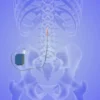Ankylosing Spondylitis is a form of arthritis that causes chronic pain and restricted motion in the lower back. In advanced cases of this disease, the spinal bones join, greatly restricting the patient’s range of motion.
Causes
It is not clear why some people develop ankylosing spondylitis and others do not. However, there are certain groups that are more likely to get this disease.
- Men are three times more likely to develop ankylosing spondylitis than women
- Caucasians and Asian populations are more likely to develop it than African-Americans
- There is a strong genetic factor
- Young adults are more likely to develop symptoms than children or older adults
Ankylosing spondylitis affects about 1% of the general population. However, it affects 5-6% of those who carry the HLA-B27 gene.
Symptoms
Patients with ankylosing spondylitis typically complain of back pain that does not improve with rest, although it does improve with exercise or movement. There is a decreased range of motion in the spine, and possibly the hips and shoulders. There may be breathing difficulties because of decreased chest expansion. Concurrent diseases may include arthritis in other parts of the body, colitis, tendinitis, and inflammatory bowel disease.
In advanced cases, patients may experience blurred vision, eye pain, or sensitivity to light. In such cases, an ophthalmologist should be consulted immediately
Diagnosis
Patients usually seek medical treatment because of pain in the lower back or buttocks. Generally, the pain must be present for three months before this diagnosis is considered.
Diagnosis is usually made by a physical examination in conjunction with an MRI or CT scan.
Treatment
Early diagnosis is important. If the condition is diagnosed and treated in its earliest stages, this can greatly reduce loss of function. Physical therapy can be helpful in the beginning to educate patients on proper stretching and breathing exercises.
Prognosis
There is no cure for ankylosing spondylitis, but the disease is rarely life-threatening. It does not affect most patients’ ability to work. In addition, there are many things that patients can do to manage the condition.
The first course of treatment is generally NSAIDs, also known as nonsteroidal anti-inflammatory drugs. This includes over-the-counter medications like Ibuprofen (Motrin) and aspirin. NSAIDs are usually effective in reducing pain and inflammation, particularly in the early stages of this disease. At times, steroidal injections can help to reduce symptomatic pain, at least on a temporary basis.
It is essential for patients to engage in daily stretching and breathing exercises to maintain their range of motion. It is also helpful to have good posture, use a firm mattress, and stop all tobacco use (smoking is associated with poor outcomes). Patients with severely reduced flexibility in their backs can purchase adaptive devices, such as wider rear-view mirrors for use while driving.
Ankylosing Spondylitis is a chronic condition. However, like many inflammatory diseases, patients have good days and bad days, depending on a variety of factors. A patient who is diligent about exercise and medication management can experience a good quality of life while living with this disease.
If you are interested in learning more, give us a call at (210) 690-0777.




